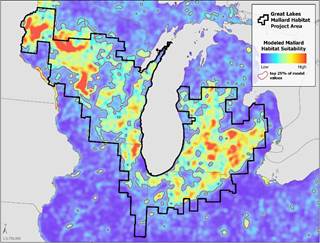Great Lakes Mallard Habitat Targeted
Ducks Unlimited biologists representing five different states have partnered with 14 other conservation organizations and agencies to receive a $1 million North American Wetlands Conservation Act grant aimed at increasing the breeding population of mallards in the Great Lakes.
Mallard numbers in the Great Lakes region have been on the decline, with estimates indicating their population at 18% below long-term average. These home-grown mallards are a primary component of waterfowl harvest in the Great Lakes. In Wisconsin, Michigan and Ohio, these birds comprise between one-half to three-quarters of the waterfowl hunters' daily bag. And they are harvested in great numbers by hunters in Indiana, Illinois and farther south in the flyway each fall.

The DU-led partnership will launch projects to meet the specific needs of mallards breeding in the Great Lakes region across an area most likely to produce the greatest population increases.
The project area spans 115 contiguous counties across Illinois, Indiana, Michigan, Ohio and Wisconsin including mallard breeding habitat on more than 2,000 acres of public and private land.
With more than $2.5 million of matching partner funds, DU and its conservation partners are pursuing an ambitious goal of protecting, restoring or enhancing nearly 2,000 acres of small wetland basins and adjoining grassland nesting cover throughout the core breeding area for mallards breeding in the Great Lakes region.
DU Regional Biologist Dane Cramer said the projects go beyond mallards.
"The breeding habitat needs of mallards intersects with two of the Upper Mississippi Joint Venture's other three breeding waterfowl focal species, wood ducks and blue-winged teal," Cramer said.
Projects funded by the NAWCA grant were chosen with special consideration to people, too. Access to recreational hunting and birding are crucial components, as well as improving water quality.
Many of the projects are on public land, but not enough public acres exist to have the impact necessary to improve mallard numbers. To address this, $400,000 of grant funds will support private land restoration efforts throughout the Great Lakes project area, with roughly $100,000 to each of the U.S. Fish and Wildlife Service's Private Lands Offices in Wisconsin, Illinois, Indiana and Michigan.
Ducks Unlimited uses cookies to enhance your browsing experience, optimize site functionality, analyze traffic, and deliver personalized advertising through third parties. By continuing to use this site, you agree to our use of cookies. View Privacy Policy